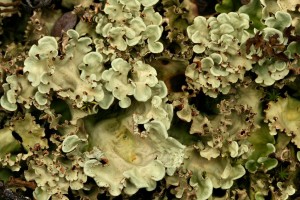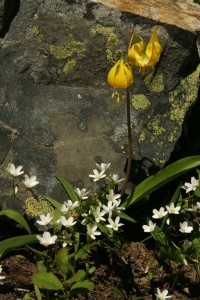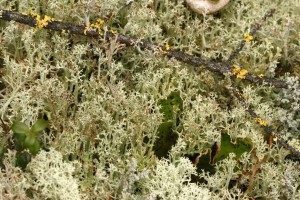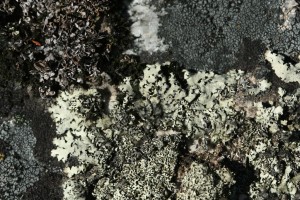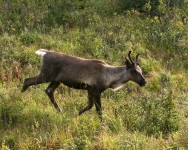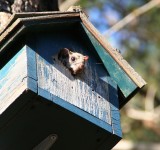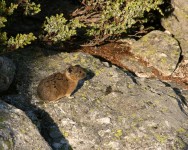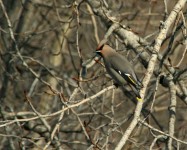I’ve noticed lichens before on rocks, trees and high alpine ridges before but didn’t look closely at them until recently. Peter Nelson, a lichenologist who studied lichens in Gates of the Arctic National Park this summer, hosted a lichen walk one evening in Bettles, Alaska and enthusiastically shared his knowledge of lichens, rattling off latin names without skipping a beat and pointing out lichens easily missed.
Lichens are in a category by themselves. They are not like trees, mosses or even mushrooms. Lichens are a combination of fungi and algae on a microscopic level–not a fungus with alga growing on the outside. Separately, the fungus and alga would look completely different than the form created when they grow together as a lichen. The fungus isn’t the typical cap and gill mushroom one might first think of, but instead a type of cup fungus.
Basically, the fungus is the house in which the alga creates food. Alga photosynthesize and provide the fungus with carbohydrates, vitamins and proteins. In return, the fungus shelters the alga and protects it from the sun and predators. The physical manifestation of this relationship is the lichen.
Unlike other plants, lichens do not derive any nutrition from the substrate on which they grow, such as soil or tree bark. They are a completely self-contained because the algae creates all the food the fungi needs. That is why lichens can grow on rocks.
Lichens will actually be one of the first species to colonize an area, such as after a glacier retreats or after a fire, because they don’t rely on anything outside of themselves to grow (besides sunlight, water and air for photosynthesis). Their growth on gravestones has allowed scientists to calculate their rate of growth because the earliest date of growth is written in stone. This growth rate can then be used to determine when the earliest time a glacier could have retreated from an area or to date an archeological site.
Even though lichens grow relatively slowly, they can survive thousands of years if left undisturbed. Amazingly, lichens can completely dry out and not die. With the next rain, dew or snow melt they will rehydrate and keep growing.
This dryness is evident when walking on a high alpine ridge as they crunch underfoot. This breaks up the lichen, but all is not lost–each of the fragments will grow into a new lichen. And if the powdery substance found on those crushed lichens sticks to your boot for a few steps or a few miles, you will help the lichen spread. That powdery substance is composed of tiny chunks of fungi/algae combinations ready to colonize a new area. The powder will also stick in the hooves of several of the animals that eat it, such as caribou, deer, elk, pronghorn antelope and Dall sheep. Lichen powder can also be spread when flying squirrels and birds utilize pieces of lichens for nesting material.
The different fungi and algae combinations produce the different lichens. Even without knowing the names, you’ll be able to differentiate the three main groups of lichens–foliose (leaf-like), fruticose (shrub-like) and crustose (paint- or stain-like). Rocks are often dotted with different colored crustose lichens. The green or black ‘old man’s beard’ dangling from old tree branches is a fruticose lichen. Foliose lichen is often found on the ground and on tree bark.
Some areas are extremely lichen-rich, such as the location I went to on the lichen walk. Within a one square-foot area, we counted 13 different lichens that included some from each lichen group, which I thought was an impressive amount of diversity for a small area in the arctic. As Peter was eagerly rambling off the different names of the lichens, his enthusiasm sparked a new interest that will have me down on my hands and knees examining lichens a little more closely.

